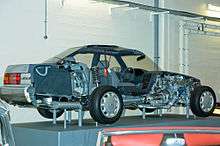Lexus LS
| Lexus LS | |
|---|---|
 Lexus LS 600h L | |
| Overview | |
| Manufacturer | Lexus (Toyota) |
| Also called | Toyota Celsior (Japan) |
| Production | May 1989–present |
| Assembly | Japan: Tahara, Aichi |
| Body and chassis | |
| Class | Full-size luxury car |
| Body style | 4-door sedan |
| Layout |
Front engine, rear-wheel drive Front engine, all-wheel drive |
The Lexus LS (Japanese: レクサス・LS, Rekusasu LS) is a full-size luxury car serving as the flagship model of Lexus, the luxury division of Toyota. Now in its fourth generation, all LS models have featured V8 engines and rear-wheel drive, with Lexus also offering all-wheel drive, hybrid, and long-wheelbase variants.
As the first model developed by Lexus, the LS 400 debuted in January 1989 with the second generation debuting in November 1994. The LS 430 debuted in January 2000 and the LS 460/LS 460 L series in 2006. A domestic-market version of the LS 400 and LS 430, badged as Toyota Celsior (Japanese: トヨタ・セルシオ, Toyota Serushio), was sold in Japan until the Lexus marque was introduced there in 2006. In 2006 (for the 2007 model year) the fourth-generation LS 460 debuted the first production eight-speed automatic transmission and an automatic parking system. In 2007, V8 hybrid powertrains were introduced on the LS 600h/LS 600h L sedans.
Development of the LS began in 1983 as the F1 project, the code name for a secret flagship sedan. The resulting sedan followed an extended five-year design process at a cost of over US$1 billion, and premiered with a new V8 engine and numerous luxury features. The Lexus LS was intended from its inception for export markets, and the Lexus division was formed to market and service the vehicle internationally. The original LS 400 debuted to strong sales, and was largely responsible for the successful launch of the Lexus marque.
Since the start of production, each generation of the Lexus LS has been manufactured in the Japanese city of Tahara, Aichi. The LS name stands for "Luxury Sedan".[1] Some Lexus importers use the backronymic name, "Luxury Saloon".[2]
First generation (XF10)
| First generation (LS 400) | |
|---|---|
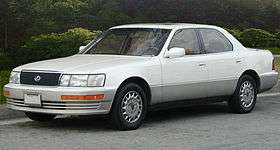 | |
| Overview | |
| Also called | Toyota Celsior (Japan) |
| Production | May 1989 – September 1994 |
| Model years | 1990–1994 |
| Designer | Kunihiro Uchida (1986) |
| Powertrain | |
| Engine | 4.0 L 1UZ-FE V8 |
| Transmission | 4-speed A341E automatic |
| Dimensions | |
| Wheelbase | 2,814 mm (110.8 in) |
| Length | 4,996 mm (196.7 in) |
| Width | 1,821–1,829 mm (71.7–72.0 in) |
| Height | 1,405–1,415 mm (55.3–55.7 in) |
| Curb weight | 1,705–1,750 kg (3,759–3,858 lb) |
1989–1992
In August 1983, Toyota chairman Eiji Toyoda initiated the F1 project ("Flagship" and "No. 1" vehicle; alternatively called the "Circle-F" project), a clandestine effort aimed at producing a world-class luxury sedan for international markets.[3][4] The F1 development effort did not have a specific budget or time constraints, and the resulting vehicle did not utilize existing Toyota platforms or parts.[5][6] Instead, chief engineer Ichiro Suzuki sought to develop an all-new design, aiming to surpass rival American and European flagship sedans in specific target areas, including aerodynamics, cabin quietness, overall top speed, and fuel efficiency.[7] During development, 60 designers, 1,400 engineers split up into 24 teams, 2,300 technicians and over 200 support workers[8] built approximately 450 flagship prototypes and 900 engine prototypes[9] and logged 2.7 million kilometres of testing on locations ranging from winter Europe roadways; deserts in Arizona, Australia, and Saudi Arabia; to U.S. highways and wilderness areas.[10][11]
In May 1985, designers started work on the F1 project. In late 1985, designers presented the first exterior study models to F1 management, featuring a sports car-like design with a low-slung hood and narrow front profile.[12] By 1986, the sedan used a three box design with an upright stance, more prominent grille, and a two-tone body.[12] Extensive modeling and wind tunnel tests resulted in a low drag coefficient for a conventional production vehicle of the time (Cd 0.29).[13] For the passenger cabin, materials selection tests evaluated 24 different kinds of wood and multiple types of leather for two years before settling on specific trim combinations.[14] By 1986, the Lexus marque was created to support the launch of the flagship sedan,[15] and the vehicle became known as the Lexus LS.[10] Following eight design reviews, subsequent revisions, concept approval in September 1986, and over US$1 billion in development expenses, the final design for the production Lexus LS 400 (chassis code UCF10) was frozen in May 1987 with design patents filed on 13 May 1987.[9][16][17]
In January 1989, the LS 400 made its debut as a 1990 model at the North American International Auto Show, in Detroit, Michigan.[18] U.S. sales began in September 1989, followed by limited exports to Australia, Canada, and the United Kingdom.[19] The LS 400's new 4.0 liter 1UZ-FE 32-valve V8 engine, capable of 190 kilowatts (250 hp) and 353 newton metres (260 ft·lbf) of torque,[20] was linked to a new four-speed automatic transmission with ECT-i electronically controlled shifts, super-flow torque converter and rear differential.[21] The chassis used an independent, double-wishbone suspension setup,[22] and a passive air suspension system was optional.[23] The LS 400's 0–100 kilometres per hour (62 mph) time was 8.5 seconds, and its top speed was 250 kilometres per hour (160 mph).[24] Compared to the rival target BMW 735i (E32) and Mercedes-Benz 420 SE (W126), the LS 400 had a quieter cabin, with 58 dB at 100 kilometres per hour (62 mph); a higher top speed; a lower drag coefficient and curb weight; and it avoided the U.S. Gas Guzzler Tax.[25][26][27] At its introduction in 1989, it won the Car of the Year Japan award.
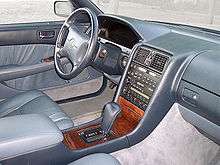
The LS 400 was among the first luxury sedans to feature an automatic tilt-and-telescoping steering wheel with SRS airbag, power adjustable shoulder seat belts, and an electrochromic rear-view mirror.[28][29] The five-passenger cabin included California walnut and leather trim, power-adjustable seats, and soft-touch controls. A back-lit electroluminescent gauge cluster featured a holographic visual effect, with indicator lights projected onto the instrument panel.[28][30] The memory system stored the driver's seat, side mirror, steering wheel, and seat belt positions. Available luxury options included a Nakamichi premium sound system and an integrated cellular telephone with hands-free capabilities.[21][31][32] The LS 400 further contained some 300 technological innovations to aid smooth operation and silence,[21] including fluid-damped cabin fixtures,[33] vibration-insulating rubber mounts,[34] airflow fairings,[35] and sandwich steel body panels.[34]
_sedan_02.jpg)
In Japan, the launch of Lexus was complicated by Toyota's existing four domestic dealership networks at the time of its introduction.[36] The Toyota Crown and Toyota Century were exclusive to Toyota Store locations.[37] During the LS 400's development, local dealers' requests for a Japanese domestic market version had grown,[12] and a right-hand-drive Toyota Celsior-badged version was introduced shortly after the LS 400's U.S. debut, and introduced 9 October 1989 and only available at Toyopet Store locations.[38] The Celsior, named after the Latin word for "supreme", was largely identical to the LS.[38] Models came in either basic "A", upgraded suspension "B", or fully equipped "C" trim specifications.[39] The Crown and the Crown Majesta, which appeared later in 1991, were only available at Toyota Store locations which carried Japan-only Toyota luxury models, like the Century.[37] The Celsior introduced two world firsts: high-performance twin-tube shock absorbers and an air suspension combined with an upgraded version of Toyota's semi-active dampers Toyota Electronic Modulated Suspension, called Piezo TEMS.[40] This was ahead of its time, Mercedes-Benz first introduced a similar electronically controlled air suspension on the 1999 Mercedes-Benz S-Class (W220) (Airmatic).
Adding incentive for early U.S. sales was a base price of US$35,000, which undercut competitors by thousands of dollars[41] and brought accusations of selling below cost from rival BMW.[21]
In December 1989, shortly after the LS 400's launch, Lexus ordered a voluntary recall of the 8,000 vehicles sold so far, based upon two customer complaints over defective wiring and an overheated brake light. All vehicles were serviced within 20 days, and the incident helped establish Lexus' customer service reputation.[21][42][43] By 1990, U.S. sales of the LS 400 had surpassed those of competing Mercedes-Benz, BMW, and Jaguar models.[44] Production of the first-generation LS 400 totaled over 165,000 units.[45] Years after its introduction, the LS 400 remained a reliable choice for a used car, making the Consumer Reports 2007 list of recommended vehicles that regularly last 320,000 km (200,000 mi) or more with proper maintenance.[46]
1992–1994
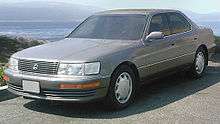
Debuting in September 1992 as a 1993 model, the refreshed LS 400 (designed in 1991) was introduced with more than 50 changes, largely in response to customer and dealer requests.[47] The vehicle received larger disc brakes, wheels, and tires, and adjustments were made to the suspension and power steering systems to improve handling.[48] Stylistic changes included additional body side moldings and a revised grille, along with a greater selection of colors.[48] For the interior, a standard passenger front airbag (first Toyota-built series production car available with passenger front airbag),[49] an external temperature gauge, digital odometer, seat belt pretensioners, and chlorofluorocarbon-free refrigerant were added.[48][50] In 1992, the Celsior introduced the world first GPS navigation system with voice instructions,[51] supplied by Aisin.[52] By 1994, the LS 400's U.S. base price exceeded US$50,000, a figure that had steadily risen since the vehicle's introduction. Customer demand for the vehicle and shifts in foreign exchange rates contributed to the increase in price.[53] The growing popularity of the LS internationally was an asset to Toyota, as Japan had entered into an economic recession in 1991, that later became what was called the collapse of the Japanese asset price bubble or "bubble economy". Production of the first-generation LS ended in September 1994 to make way for production of the second-generation model in October.
Second generation (XF20)
| Second generation (LS 400) | |
|---|---|
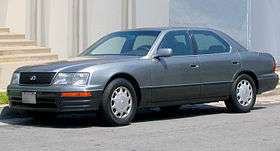 UCF20 LS 400 | |
| Overview | |
| Also called | Toyota Celsior (Japan) |
| Production | October 1994 – July 2000 |
| Model years | 1995–2000 |
| Designer | Makoto Oshima (1991) |
| Powertrain | |
| Engine | 4.0 L 1UZ-FE V8 |
| Transmission |
4-speed A340E automatic 5-speed A650E automatic |
| Dimensions | |
| Wheelbase | 2,850 mm (112.2 in) |
| Length | 4,996 mm (196.7 in) |
| Width | 1,829 mm (72.0 in) |
| Height | 1,420–1,435 mm (55.9–56.5 in) |
| Curb weight | 1,659–1,764 kg (3,657–3,889 lb) |
1994–1997
The second-generation Lexus LS 400 (UCF20) debuted in November 1994 (for the 1995 model year) with a longer wheelbase and similar specifications as the original model. The public unveiling of the vehicle occurred in a gala ceremony held at the San Francisco Opera House in California.[54] The sedan was equipped with an updated 4.0-liter 1UZ-FE V8 engine, producing 194 kilowatts (260 hp) and 366 newton metres (270 ft·lbf) of torque.[55] Internally, over 90% of the redesigned LS 400's composition was new or redesigned,[55] with increased sound insulation, a strengthened body structure, suspension updates (first LS/Celsior with Skyhook adaptive computerized air suspension[56]), and improved brakes.[55] The redesigned model was 95 kg (209 lb) lighter than its predecessor and achieved slightly better fuel economy.[55] The 0–100 kilometres per hour (62 mph) time improved to 7.5 seconds.[57]
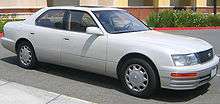
Development of the second-generation LS 400 began after worldwide launch of the first generation.[58] Given the first-generation model's successful reception and high level of customer satisfaction with its design, replicating the original LS 400's attributes with its successor was one of chief engineer Kazuo Okamoto's primary goals (he stated that "a tradition cannot be founded if you reject the first generation").[59] Externally, the most significant change was an increase in wheelbase length of 36 mm (1.4 in), resulting in more interior space and an additional 66 mm (2.6 in) of rear seat legroom.[55] However, as the overall length remained the same, trunk capacity was slightly reduced.[55] The more aerodynamic body (Cd 0.28) retained the general profile and contours of the original LS 400[48][59] and was the work of the Calty Design Research center in the U.S.[59] Designers had evaluated 20 competing concepts, including several with a radically changed body,[59] before selecting a winning entry in 1991 that included forms and contours similar to the original LS 400.[59] Upon final approval in 1992, an evolutionary redesign was the ultimate result, with new design features consisting of sharper angles, curved body lines, and a beveled grille.[60] More prominent side lines provided a reference point for parking maneuvers, and forward visibility was improved.[60] Production development lasted from 1991 until conclusion in the second quarter of 1994.[58][59][61]
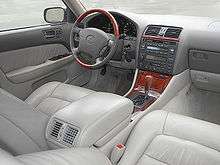
The redesigned LS 400 interior received upgraded features, varying from dual-zone climate controls to rear cupholders.[48] A newly patented seat cushion design, similar to the car's suspension, utilized lightweight internal coil springs and stabilizer bars to improve comfort.[55] One of the first in-dash CD changers was offered as an option.[55] Safety enhancements included enlarged crumple zones, three-point seat belts at all positions, and a new collapsible steering column.[55] In Japan, the Toyota Celsior equivalents were offered in the same "A", "B", and top-spec "C" configurations as before, along with an additional selection of exterior colors.[62] Several optional features, such as a compact disc-based Global Positioning System (GPS) navigation system and reclining rear seats, were available only in Japan.[63]

At its U.S. debut, the redesigned LS 400 retained a pricing advantage over European competitors in its largest market, launching with a base price of US$51,000.[55] However, cost differences had narrowed following more aggressive pricing and added feature content from rival manufacturers.[59] To promote their new flagship, Lexus launched a US$50 million advertising campaign, the most expensive marketing effort since the launch of the division.[59] In mid-1995, sales slowed as the U.S. government threatened tariffs on Japanese luxury cars over the widening U.S.-Japan trade deficit, potentially raising the price of a fully optioned LS 400 to over US$100,000.[64] Subsequent negotiations averted the sanctions by the second quarter of that year, and sales recovered in the following months.[64] Ultimately, second-generation LS 400 sales were not as voluminous as the original model;[59] production totaled approximately 114,000 units.[45]
Production of the UCF20 ran from October 1994 to July 1997. For 1997, a limited "Coach Edition" LS 400 was produced in partnership with American leather manufacturer Coach Inc. The edition featured Coach leather seats; embroidered emblems on the exterior, floormats, and armrest; special colors and added trim; and a Coach cabin bag. Production was limited to a yearly run of 2,500 units.[65]
1997–2000
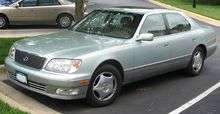
Designed in 1996, in September 1997 a revised LS 400 was introduced for the 1998 model year. Changes were a five-speed automatic transmission, increased engine output (to 216 kilowatts (290 hp), with variable valve timing (VVT-i), and an added 41 newton metres (30 ft·lbf) of torque.[48] Acceleration times and fuel economy were improved as a result.[48] The suspension and steering also received minor tweaks to improve feel and handling.[66] Stylistically, the vehicle sported a new front fascia, side mirrors, and updated wheels;[48] a rear windshield diversity antenna replaced the conventional power mast.[66] The cabin received upgrades, including a trip computer, HomeLink, retractable rear headrests, reading lamps, and ultraviolet-tinted glass,[66] while the climate control gained a micron filtration feature with a smog sensor.
In August 1997, the first production laser adaptive cruise control on a Toyota vehicle was introduced on the Celsior version (Japan only)[67][68] It controlled speed only through throttle control and downshifting, but did not apply the brakes.[69] Because of laser technology limitations, it deactivated in bad weather.
A CD-ROM-based GPS automotive navigation system became an option in the U.S. Added safety features included front side airbags, vehicle stability control and in 2000, brake assist.[48] Introduced low beam HID headlamps. The headlights were also equipped with a programmable delay feature for proximity illumination.[48] In February 2000, the limited "Platinum Series" LS 400 was introduced at the Chicago Auto Show in partnership with American Express. The edition featured most luxury options standard, along with separate exterior colors, wheels, badging, and two years' no-fee use of an American Express Platinum Card.[70][71]
Third generation (XF30)
| Third generation (LS 430) | |
|---|---|
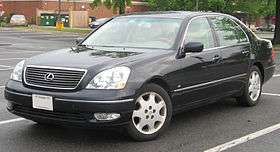 | |
| Overview | |
| Also called | Toyota Celsior (Japan) |
| Production | August 2000 – July 2006 |
| Model years | 2001–2006 |
| Designer |
Akihiro Nagaya (1997) Makoto Oshima (chief designer) Machio Nakamura (facelift: 2002) |
| Powertrain | |
| Engine | 4.3 L 3UZ-FE V8 |
| Transmission |
5-speed A650E automatic 6-speed A761E automatic |
| Dimensions | |
| Wheelbase | 2,926 mm (115.2 in) |
| Length | 4,996–5,014 mm (196.7–197.4 in) |
| Width | 1,829 mm (72.0 in) |
| Height | 1,491 mm (58.7 in) |
| Curb weight | 1,812–1,810 kg (3,995–3,990 lb) |
2000–2003
The third-generation Lexus LS 430 (UCF30) debuted at the North American International Auto Show in January 2000 as a 2001 model, introducing a new body design and a host of new interior and technological features.
It was the first US market Lexus with adaptive cruise control (called Dynamic Laser Cruise Control).[72][73] It employed a lidar sensor and (unlike the laser ACC introduced in 1997 on the Celsior) was able to activate brakes for deceleration.[69] However, because of laser technology limitations, it deactivated in bad weather.
The sedan was equipped with a new 4.3 liter 3UZ-FE engine generating 216 kilowatts (290 hp) and 434 newton metres (320 ft·lbf) of torque.[48] The LS 430 was one of the first gasoline V8 vehicles to be certified as an Ultra Low Emissions Vehicle (ULEV).[74] The standard suspension had been completely redesigned, with a double-wishbone setup at all four wheels; a Euro-tuned suspension was offered for the first time.[48] A new torque-activated electronic control unit made throttle adjustments based on vehicle speed, engine revolutions per minute, and pedal position.[72] The LS 430 sported a 0–100 kilometres per hour (62 mph) acceleration time of 6.7 seconds.[75] Sales began in October 2000 in the U.S.[76]
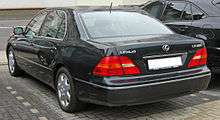
Heading into the planning of the LS 430, division executives concluded that the previous LS redesign had been too restrained in its approach.[59] The LS 430 development team, led by chief engineer Yasushi Tanaka,[77] accordingly opted for a more thorough exterior, interior, and technological redevelopment. The development of the LS 430 took four years.[78] Selected from 16 different concept designs, the resulting vehicle of December 1997—when the final design (by Akihiro Nagaya) was approved—saw the sedan's dimensions increase in terms of wheelbase and height.[72][79] The exterior featured a larger grille with rounded edges, quarter windows on the rear doors, and rounded trapezoidal headlamps. The body was also more aerodynamic than previous LS sedans (Cd 0.26; 0.25 with air suspension),[76] and was the product of wind tunnel testing at facilities used for Shinkansen bullet train development.[79] A 76 mm (3.0 in) wheelbase stretch resulted in more interior volume and allowed the engine to be positioned further aft for better balance.[80] Trunk space was increased by one-third due to repositioning of the fuel tank.[48]
Compared to previous generations, the LS 430 featured a greater number of model configurations and options.[81] While sharing the same body style, variants were differentiated by chassis configuration and onboard equipment. Models with the Euro-tuned sport suspension, sold as the "Touring" package in the U.S.,[73] featured larger, high-speed brakes.[33] These brakes were also standard on European market models.[33] Fully optioned models with height adjustable air suspension, tuned for a combination of soft ride and responsive handling, were sold in the U.S. as the "Ultra Luxury" edition.[73]
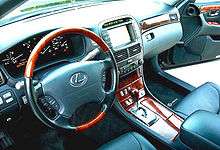
The LS 430 interior featured walnut wood trim on the dashboard and upper doors, along with semi-aniline leather and oscillating air conditioning vents.[72][76]
The GPS navigation system was totally redesigned. A liquid crystal display with touchscreen on the upper center console served as interface. First LS with voice controlled navigation. First system featuring DVD (instead of CD-ROM) maps on a luxury sedan.
Introduced a Mark Levinson premium sound system.[72][73] In its highest trim specification, the LS 430 included Lexus Link telematics, power door and trunk closers, heated and cooled front seats, and power reclining massage rear seats equipped with audio controls, power sunshade, a cooler, and air purifier.[48][76] Several rear seat features adopted for the LS 430 had been previously available in Japanese market luxury vehicles.[81] Safety features added to the LS 430 included front and rear side curtain airbags, park sensors, rain-sensing windshield wipers, and electronic brakeforce distribution.[48] The vehicle also gained water repellent windshield and side glass.[48]

The LS 430 first went on sale in the U.S. with an initial base price of US$55,000, ranging up to US$70,000 when fully equipped.[76] At the high end, the LS 430's pricing encroached on European rivals as Lexus became increasingly able to command higher price premiums for its vehicles.[28] Sales for the LS 430 surpassed the previous generation, and production exceeded 140,000 units.[45] The LS 430 was produced until July 2006, marking the last occasion the Lexus flagship was produced in a single body style. In Japan, the equivalent Toyota Celsior was also sold from August 2000 until March 2006, when the long-awaited introduction of Lexus Japan saw the arrival of new generation Lexus models.[82] XF30 design patents were filed by Toyota in domestic Japan, on 8 March 1999 at the Japan Patent Office under patent number 1080448.
In every year of production, the LS 430 was the most reliable luxury sedan in the J.D. Power and Associates Initial Quality Survey (with the early and late models of this series the best performing),[83][84][85] and the highest recorded scorer in the history of J.D. Power's Vehicle Dependability Survey.[86] Thatcham ratings data via the UK Motor Insurance Repair Research Centre listed the theft-prevention capabilities of the LS 430 as a maximum 5 stars, with the LS 430 being the first automobile to achieve the maximum theft-deterrence rating in 2001.[87][88]

2003–2006
Designed throughout 2002, the LS 430 update debuted in September 2003 as a 2004 model.
The first radar (instead of previous lidar) sensor on a Lexus sedan allowed the new Dynamic RADAR Cruise Control to work in any weather conditions. The millimeter-wave radar technology also enabled the first Pre-Collision System (PCS) on a Lexus sedan (with partial autonomous braking only on the Japanese market Toyota Celsior version).[69] A "low-speed tracking mode" was added in 2004.[69] The low-speed speed tracking mode was a second mode that would warn the driver if the car ahead stopped and provide braking; it could stop the car but then deactivated.[89]
Introduced a new six-speed automatic transmission and revised styling.[90] The powerplant remained the same as before. Exterior changes included restyled front and rear fascias, light-emitting diode (LED) taillights, and different wheels.[90]
Debuted the first Lexus high-intensity discharge headlights for the high beam (Bi-Xenon), and also the first AFS adaptive curve headlights, which swiveled the projector headlamps in the direction of vehicle turns.
The interior received knee airbags, lighted rear-seat vanity mirrors, and new trim selections, including bird's eye maple wood.[48] New options included an updated navigation system, Bluetooth, a backup camera, . A driver-programmable electronic key feature allowed the vehicle to detect the key fob in the owner's pocket and unlock the doors by touch.[91]
Fourth generation (XF40)
| Fourth generation (LS 460, LS 600h) | |
|---|---|
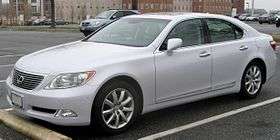 | |
| Overview | |
| Production | August 2006–present |
| Model years | 2007–present |
| Designer | Yo Hiruta[92] (2003, 2004) |
| Body and chassis | |
| Platform | Toyota N platform[93] |
| Powertrain | |
| Engine |
4.6 L 1UR-FE V8 4.6 L 1UR-FSE V8 5.0 L 2UR-FSE V8 |
| Transmission |
8-speed AA80E automatic 8-speed L110F CVT |
| Dimensions | |
| Wheelbase |
2,969 mm (116.9 in) (SWB) 3,091 mm (121.7 in) (LWB) |
| Length |
5,029–5,060 mm (198.0–199.2 in) 5,151–5,179 mm (202.8–203.9 in) |
| Width | 1,875 mm (73.8 in) |
| Height | 1,466–1,481 mm (57.7–58.3 in) |
| Curb weight | 1,925–1,965 kg (4,244–4,332 lb) |
2006–2009
Development on fourth generation LS began in 2001, with the design process being done under Yo Hiruta from 2002 to 2004 when the final production design was frozen.[92][94][95] In October 2005, Lexus premiered a gasoline-electric hybrid concept car, the LF-Sh (Lexus Future-Sedan hybrid), at the Tokyo Motor Show,[96] publicly previewing the next Lexus flagship with a concept version for the first time. Introduced at the January 2006 North American International Auto Show for the 2007 model year, the fourth-generation Lexus LS became the first Lexus model to be produced in both standard and long-wheelbase versions. Using an all-new platform,[97][98] the LS 460 (USF40) uses the standard 2,969 mm (116.9 in) wheelbase, while the LS 460 L (USF41) features a stretched 3,091 mm (121.7 in) wheelbase.[99] The fourth-generation models' technical specifications were shown in greater detail at the Geneva Motor Show in February 2006.[100] A hybrid version, LS 600h L (UVF46), was previewed at the New York International Auto Show in April 2006.[101] At its introduction in 2006, it won the Car of the Year Japan award for the second time.
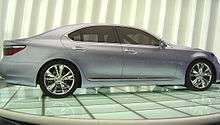
The LS 460 and LS 460 L are both equipped with a new 4.6 liter 1UR-FSE V8 producing 283 kilowatts (380 hp) and 498 newton metres (367 ft·lbf) of torque,[99][102] coupled to the first production eight-speed automatic transmission.[103] Acceleration from 0–100 kilometres per hour (62 mph) is listed at 5.7 seconds.[104]
The development of the LS 460 and its variants, led by chief engineer Moritaka Yoshida,[105] began as Lexus was shifting its design strategy towards a more diversified product lineup,[106] with new-vehicle launches largely focused on global markets.[106] Plans called for the next-generation LS to differentiate itself further beyond previous models in terms of design and technology.[102] A "Super LS" model, priced above the US$100,000 ultra-luxury category,[107] was also considered.[106] Externally, the Lexus LS received the styling cues of Lexus' new design direction, called L-finesse.[108] First shown on the LF-Sh concept, the vehicle gained body forms running the length of the car, wheel arches, arrow-shaped chrome trim, a lower-set grille, and crystalline adaptive headlamps.[108]

The LS 460 interior gained a push-button start, thin-film transistor instrument display, and numerous luxury options, ranging from a hard disk drive-based GPS navigation system and song library to a heated steering wheel and XM NavTraffic.[99] Standard equipment included power 16-way driver and 12-way front passenger seats with lumbar adjustment and seat heaters, leather upholstery, premium sound system, power moonroof, and trunk pass-through.[99] The climate control offered the first infrared body temperature sensors in an automobile; it also featured ceiling air diffusers.[109] An "Executive" seating package on the LS 460 L included a rear-seat DVD entertainment system, swivel tray table, and a shiatsu massaging ottoman seat.[99][110]
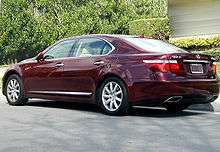
It was the first LS with continuous controlled Adaptive Variable Suspension AVS. The addition of an automated parallel parking assist feature, the first of its kind in the U.S., allowed the LS 460 to steer itself into preselected parking spaces.[111] Other drive-assist features included a brake-hold system, radar cruise control, electric variable gear ratio power steering, and electronically controlled braking.[99] The new stability control system was improved to anticipate skids and alter steering assist and gear ratios. The suite of new safety features extended from an eye-tracking Driver Monitoring System to a lane departure warning system.[112][113] The pre-collision system added the first production image processing chip in a car capable of identifying vehicles and pedestrians in real time,[114][115] along with millimeter-wavelength radar, stereo cameras, and infrared night vision projectors.[114] A rear pre-collision system with whiplash-preventing active seat headrests and dual-chamber front airbags was also introduced.[112][116]
The LS 460 and LS 460 L arrived at dealerships in Japan, the U.S., and Europe in late 2006,[117] and the vehicle reached Australia, East Asia, and the Middle East in 2007.[118] The U.S. base prices for the 2007 LS 460 and LS 460 L were US$61,000 and US$71,000, respectively.[110] In 2006 and 2007, the average price paid for U.S. market LS 460 L sedans exceeded US$80,000, due largely to added options packages, placing the Lexus LS in the same average price range as its long-wheelbase Audi, BMW, and Jaguar rivals for the first time.[110]
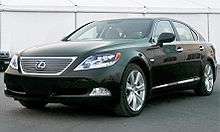
After debuting a hybrid powertrain with the 2005 LF-Sh concept, Lexus began sales of the LS 600h L (UVF46), the first production V8-powered full-hybrid vehicle,[119] in May 2007 for the 2008 model year. The long-wheelbase LS 600h L is equipped with Lexus Hybrid Drive, featuring a 5.0 liter 2UR-FSE V8 engine mated to a high-output electric motor with nickel-metal hydride battery packs.[105] This system uses a continuously variable transmission and generates an output of 327 kilowatts (439 hp).[105] Fuel economy is slightly higher overall than the lower-powered non-hybrid LS, and the hybrids achieve a U.S. Super Ultra Low Emission Vehicle (SULEV) rating.[120][121] Features specific to the LS hybrids include the first production low beam LED headlights, a leather-trimmed dash, and blue-tinted hybrid badging.[101] In April 2007, Lexus announced that the base price for the LS 600h L would be over US$104,000,[122] surpassing the V12-equipped Toyota Century as the most expensive Japanese luxury car ever produced.[122] A standard-wheelbase version destined for Asia and Europe, the LS 600h (UVF45), was launched in Japan in May 2007.[123] The first 100 LS 600h L sedans sold in the U.S. were offered as "Launch Edition" models via the Neiman Marcus catalog for InCircle members.[124]
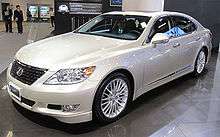
In 2008, all-wheel drive versions of the non-hybrid LS 460 (USF45) and LS 460 L (USF46) models premiered at the Moscow International Motor Show.[125] Debuting at the 2008 Pebble Beach Concours d'Elegance,[126] the LS 600h L "Pebble Beach Edition", limited to 50 units, was produced in partnership with the Pebble Beach Company.[127] A specialized Lexus LS 460 was installed as a driving simulator at Toyota's Higashifuji Technical Center, in Shizuoka, Japan, for automotive safety testing,[128] and in 2009 at Tokyo's Intelligent Transport Systems (ITS-Safety) exhibition, the LS 460 ITS-Safety concept was unveiled showing road-to-vehicle and vehicle-to-vehicle information-exchange technologies.[129]
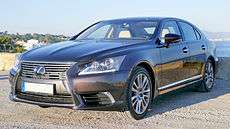
2009–2012
Debuting in late 2009 for the 2010 model year, the revised LS 460 and LS 460 L included restyled front and rear fascias, side mirror turn signals, and new wheel designs.[130] New technology included automatic high beam lights and a self-repairing clear coat for the exterior paint.[131][132] The standard cabin received additional chrome trim, an optional DVD entertainment system behind the center armrest, and in certain markets, an all-digital instrument panel with night vision capability.[130] The LS 460 Sport—a performance variant equipped with a sport-tuned air suspension, Brembo brakes, forged wheels, paddle shifters, body kit, and a unique interior—was added.[130][131] The Sport model received the Sport Direct Shift transmission, also found in the Lexus IS F, with downshift rev-matching capability and manual mode.[133] A new interior customization program, "L-Select", also became available for LS customers in Japan.[130]
2012–present
Lexus released an official photograph of its restyled XF40 series in July 2012. The substantial update incorporates the new Lexus corporate fascia, comprising the "spindle" grill and consequently sees the fitment of a redesigned hood, reshaped front fenders and headlamps, plus a new bumper.[134] These styling revisions see the retention of the side profile and doors, including rear fenders. Thus, the newly designed tail-lamps, trunk lid, and rear bumper are only partially modified. For the first time, an F-Sport variant will be offered. 'Nanoe' technology is used in the air conditioning system where 20–50 nm ions are bonded to water molecules.[135][136]
Manufacturing
The Lexus LS has been consistently produced on dedicated Lexus assembly lines at Toyota's flagship Tahara factory,[137] located in the city of Tahara, in Aichi Prefecture, Chūbu region, southwest of Nagoya, since 1989.[102][138] Tahara remains the sole production site, having inaugurated its new line number four specifically for assembly of the original LS 400.[139]
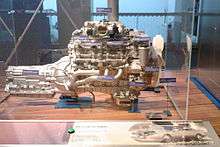
For the Lexus LS, the Tahara plant developed new molds and enhanced assembly techniques[140][141] and instituted measures aimed at increasing the precision of the sedan's fit and finish.[18] The 1989 LS 400 became the first production automobile to receive extensive laser welding,[140][142] allowing for seamless steel welds.[141] A large sheet metal press was developed to reduce or eliminate panel gaps by stamping large sections whole instead of singly.[141] Separately installed parts, such as exterior lights, were also spring-loaded for a tighter fit.[142] On the LS 400, engineers reduced door panel gaps in half versus Toyota-brand vehicles, from 7 mm (0.28 in) to 4 mm (0.16 in),[141] with measurements made within 0.01 millimetres (0.00039 in);[76] on the LS 430, measurement margins were increased tenfold, to 0.001 mm (3.9×10−5 in).[76][143] When production switched to the LS 460, the number of laser welds was doubled.[144]
Despite Tahara's large-scale automation, Lexus LS production also involves specialized personnel who are tasked with key production points, such as testing each vehicle's V8 engine via dynamometer and stethoscope for calibration before installation.[102][145] With the LS 460, a hand-sanded paint process was introduced.[102] The production standards used on the Lexus LS were eventually adopted by the manufacturer for other vehicles; in 2007, the assembly of Toyota Corolla economy cars used the same panel gap measurements as the LS 400 did eighteen years earlier.[146]
Industrial significance
The Lexus LS marked the first successful entrant of a Japanese manufacturer into the prestige luxury arena,[44] a market that had long been dominated by established European and American brands. By 1991, with the LS 400 its top-selling model,[147] Lexus had overtaken Mercedes-Benz and BMW in overall U.S. sales,[148] and in 2000, the marque passed Cadillac as the luxury sales leader in the largest automotive market.[149] Rival manufacturers responded with lower prices and added features.[150] In particular, Mercedes-Benz reorganized its operations, shifting to a targeted-cost process similar to Lexus production methods,[151] and dropped competing U.S. base prices by nearly 10 percent.[152] To rival the LS 400,[153] extra features were rushed for the launch of the 1991 Mercedes-Benz S-Class (W140),[151][154] causing budget overruns and costing the job of Daimler-Benz's chief engineer, Wolfgang Peter.[153] Approximately 5 percent of 1989 LS 400 sales went to buyers employed by rival manufacturers, including GM, Ford, and Chrysler.[147] When the LS 400 was disassembled for engineering analysis, Cadillac engineers concluded that the vehicle could not be built using existing GM methods.[155] Industry publications noted the LS 400's precise panel gaps, and the subject became a common evaluation standard in road tests.[153] The LS 430's interior noise level was later used by rival makes as a measure of cabin quiet.[156]
According to industry observers, the introduction of the Lexus LS reshaped Toyota's image from that of an "econobox" manufacturer to the builder of an automotive standard bearer.[157][158] This stood in contrast to the predictions of early detractors, including rival manufacturers who dismissed Toyota as incapable of producing a competitive luxury vehicle.[158] Japanese contemporaries from the luxury divisions of Honda (Acura) and Nissan (Infiniti) had differing degrees of success.[159] Honda had entered into a joint venture with Britain's Austin Rover Group in November 1981, launching Project XX with an Austin Rover–Honda XX letter of intent to replace the Rover SD1 with the Rover 800 and to provide a midsize, V6-powered luxury sedan for Honda, called the Honda Legend.[160] Marketed as the Acura Legend in the U.S., the sedan initially sold well, but subsequent models (renamed Acura RL) performed below sales expectations.[161][162] Launched by Nissan in December 1989, the V8-powered Infiniti Q45 closely rivaled the LS 400 in specifications and price,[163] but was unsuccessful in sales (attributed to unconventional styling and marketing), leading to its discontinuation in 2006.[164] The success of the Lexus LS became a test case for mainstream manufacturers targeting upscale segments. By investing in a separate marque, Toyota was able to avoid the stigma attached to a mass-market brand's charging premium prices.[165] The effect of the LS 400 on the automotive industry led Automobile Magazine to add the sedan to its "24 Most Important Vehicles of the 20th Century" list in 1996.[166]
Lexus LF-FC concept

The Lexus LF-FC Concept, first shown at the 2015 Tokyo Motor Show previews the next generation LS flagship sedan. The front of the concept is dominated by Lexus's signature "spindle grille" and the entire car has an aggressive angular design.
Sales and production
_sedan_(2011-04-22)_01.jpg)
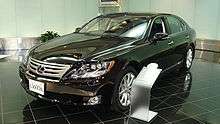
In its largest market, the U.S., the Lexus LS was the top-selling flagship luxury sedan for 15 of the first 17 years following its debut.[103][167] In Japan, the next-largest market for the Lexus LS, the introduction of the 2007 LS 460 attracted 12,000 pre-orders,[82] and the Lexus LS has gone on to sell successfully in its class.[168] Following the introduction of the LS 460 and Lexus' expanded global launch in 2007,[169] sales of the Lexus flagship have increasingly come from outside the brand's traditional U.S. strongholds. By 2007, the Lexus LS ranked second globally in flagship sales, next to the Mercedes-Benz S-Class' 85,500 units, with 71,760 Lexus LS sedans sold worldwide,[170] and over half the total coming from outside the U.S. market.[171] In 2008, U.S. sales fell 42% amidst the late-2000s recession, mirroring the overall decline of the luxury car market.[172]
The Lexus LS has not sold as well in Europe, where Lexus suffers from smaller brand recognition, image, and a less-developed dealership network.[173] In European markets such as the Czech Republic, the Lexus LS has ranked behind Mercedes-Benz, Audi, and BMW in flagship luxury car sales.[174] Automotive analysts have suggested a possible rationale for the sales disparity, in that European buyers place less emphasis on vehicle reliability and have more brand loyalty to established domestic marques.[173] In contrast, the Lexus LS has ranked second in sales to the Mercedes-Benz S-Class (and ahead of rivals from BMW, Audi, and Jaguar) in markets outside Europe, such as South Africa.[175]
| Calendar year | Sales | Exports, production‡ | |
|---|---|---|---|
| US | Global | ||
| 1990 | 42,806[176] | 41,901[45] | |
| 1991 | 36,955[176] | 41,228[45] | |
| 1992 | 32,561[176] | 32,472[45] | |
| 1993 | 23,783[177] | 28,187[45] | |
| 1994 | 22,443[177] | 21,390[45] | |
| 1995 | 23,657[178] | 22,433[45] | |
| 1996 | 22,237[179] | 22,810[45] | |
| 1997 | 19,618[180] | 17,782[45] | |
| 1998 | 20,790[79] | 22,730[45] | |
| 1999 | 16,357[79] | 17,198[45] | |
| 2000 | 15,871[181] | 11,098[45] | |
| 2001 | 31,110[182] | 31,473[45] | |
| 2002 | 26,261[183] | 27,033[45] | |
| 2003 | 23,895[184] | 21,461[45] | |
| 2004 | 32,272[185] | 31,697[45] | |
| 2005 | 26,043[185] | 28,902[45] | |
| 2006 | 19,546[186] | 34,833[170] | 30,908‡[187] |
| 2007 | 35,226[188] | 71,760[170] | 72,279‡[189] |
| 2008 | 20,255[188] | 31,823‡[190] | |
| 2009 | 11,334[191] | 18,369‡[192] | |
| 2010 | 12,275[193] | ||
| 2011 | 9,568[194] | ||
| 2012 | 8,345[194] | 17,578‡[195] | |
| 2013 | 10,727[196] | ||
| 2014 | 8,559[197] | ||
| 2015 | 7,165[198] | ||
Technical specifications
| Drivetrain specifications by generation | ||||||
|---|---|---|---|---|---|---|
| 1989–1994 | 1994–1997 | 1997–2000 | 2000–2006 | 2006– | 2007– | |
| Engine | 4.0 L V8 | 4.0 L V8 | 4.0 L V8 | 4.3 L V8 | 4.6 L V8 | 5.0 L V8 hybrid |
| Gears | 4 | 4 | 5 | 5–6 | 8 | CVT |
| Power | 190 kW (250 hp)[199] | 190 kW (260 hp)[200] | 220 kW (290 hp)[201] | 220 kW (290 hp)[202] | 255 kW (342 hp)[203] 288 kW (386 hp)[99] |
327 kW (438 hp)[105] |
| Torque | 353 N·m (260 ft·lbf) @4400 rpm[199] | 366 N·m (270 ft·lbf) @4500 rpm[200] | 407 N·m (300 ft·lbf) @4000 rpm[201] | 434 N·m (320 ft·lbf) @3400 rpm[202] | 455 N·m (336 ft·lbf) @4100 rpm[203] 498 N·m (367 ft·lbf) @4100 rpm[99] |
520 N·m (380 ft·lbf) @4000 rpm |
| Model configurations by region | |||||||
|---|---|---|---|---|---|---|---|
| Chassis code | Model no. | Model year(s) | Drivetrain | Transmission | Engine type | Engine code | Region(s) |
| USF40 | LS 460 | 2007– | RWD/AWD | 8-speed automatic |
4.6 L petrol V8 | 1UR-FSE | United States,[99] Canada,[204] Japan,[205] Europe,[104] Middle East (2011–) |
| 1UR-FE | Middle East (2007–2010)[206] | ||||||
| USF41 | LS 460 L | 1UR-FSE | United States,[99] Canada,[204] Japan,[205] Middle East (2011–) | ||||
| 1UR-FE | Middle East (2007–2010)[206] | ||||||
| UVF45 | LS 600h | 2008– | AWD | CVT | 5.0 L hybrid V8 | 2UR-FSE | Japan,[205] Europe[104] |
| UVF46 | LS 600h L | United States,[105] Canada,[204] Japan,[205] Europe,[104] Middle East (2010–) | |||||
Awards
Notable examples of awards received by the Lexus LS include (2007) World Car of the Year, International Car of the Year, (1991) Canadian Car of the Year,[207] Wheels Car of the Year,[208] and Top Gear Limousine of the Year.[209] The Lexus LS has been the highest-rated luxury car in Automobile Magazine,[210] Car and Driver,[211][212] Consumer Reports,[213][214] Fleet World,[215] and MotorWeek.[216] In J.D. Power's long-term Vehicle Dependability Study, the Lexus LS has been the most reliable car for fifteen consecutive years,[217][218][219] the most for any manufacturer,[220][221][222] and Consumer Reports has ranked the sedan as the most reliable vehicle tested.[223][224][225][226] Safety awards include Auto Bild's 2007 Innovation Prize for the LS 460 pre-collision system,[227] consecutive first place rankings in the What Car? Security Supertest,[228][229] and Kiplinger's "Best in Safety for Cars $40,000 and Over".[230] Technical honors range from Ward's 10 Best Engines,[231][232] and Edmunds.com's "Best Sound System in Cars Over $30,000".[233]
In U.S. consumer publications, Lexus' flagship model is recognized as one of the most reliable vehicles ever built, having held the top ranking in J.D. Power and Associates' U.S. Vehicle Dependability Survey for fifteen consecutive years (1994–2009), again in 2012,[234] third place in 2013,[235] and top again in 2014.[236]
References
- ↑ "1st Lexus LS (LS460) sedan". Toyota Motor Corporation. 2012. Retrieved 2012-12-30.
- ↑ "Site Map". Australia: Lexus. Archived from the original on 2014-04-11.
- ↑ Dawson, Chester (2004), Lexus: The Relentless Pursuit. John Wiley & Sons (Asia) Pte Ltd., Singapore. p. 4. ISBN 0-470-82110-8.
- ↑ May, Matthew E. (2006), The Elegant Solution: Toyota's Formula for Mastering Innovation, Free Press, NY. p. 43. ISBN 0-7432-9017-8.
- ↑ Dawson 2004, p. xxi
- ↑ Mahler, Jonathan (2004), The Lexus Story: The Behind the Scenes Story of the #1 Automotive Luxury Brand in America, DK Melcher Media, NY. p. 31. ISBN 0-9717935-7-3.
- ↑ Dawson 2004, pp. 45–46
- ↑ "Lexus LS 400 - a history". Lexus UK Blog. Lexus UK. Retrieved 2015-04-01.
- 1 2 Dawson 2004, pp. 24, 70
- 1 2 Dawson 2004, pp. 50–51
- ↑ Mahler 2004, pp. 46–48
- 1 2 3 Dawson 2004, pp. xvii, 42–43
- ↑ Long, Brian (2001), Lexus: The Challenge to Create the Finest Automobile. Veloce Publishing, Cardiff. pp. 19–20. ISBN 1-901295-81-8.
- ↑ Dawson 2004, p. 52
- ↑ Morgan, James M. & Liker, Jeffrey K. (2006), The Toyota Product Development System: Integrating People, Process and Technology, Productive Press, NY. p. 121. ISBN 1-56327-282-2.
- ↑ Wakefield 1989, p. 35
- ↑ https://www.youtube.com/watch?v=2YfVEImFz7k
- 1 2 Mahler 2004, p. 78
- ↑ "Edmunds.com Lexus Overview". Edmunds.com. Retrieved 2011-02-22.
- ↑ Bedard, Patrick. (1989–12) "Comparison Test: Showdown." Car and Driver, Vol. 35, Issue 6.
- 1 2 3 4 5 Detroit, S.C. Gwynne (1990-09-17). "New Kid on the Dock". Time. Retrieved 2007-04-29.
- ↑ Yap, Chips (2006-12-12). "The creation of Lexus". Malaysian Motor Trader. Archived from the original on 2008-03-22. Retrieved 2008-08-21.
- ↑ Long 2001, p. 22
- ↑ "Lexus LS 400 1990 – 1995 specifications". Autoevolution.com. 2009. Retrieved 2009-06-05.
- ↑ Dawson 2004, pp. 63, 68–71 "0–60: 7.9 sec."
- ↑ Comparison data: LS 400 (250 km/h, Cd 0.29, 1710 kg); 735i (220 km/h; Cd 0.37, 1760 kg; 420 SE 222 km/h, Cd 0.32; 1760 kg)
- ↑ Dawson 2004, pp. xxi, 64
- 1 2 3 Pacic, Milo (2004-09-23). "Lexus (in the lap of latent luxury)". AutomoBear.com. Archived from the original on 2006-05-23.
- ↑ Woodcock, Glen. "Living Large in Lexus." Calgary Sun. Retrieved 2007-04-08.
- ↑ Long 2001, p. 27
- ↑ Bloom, Craig (1989-06-11). "What's new in car stereos; in the auto sound race, Detroit speeds ahead". The New York Times. Retrieved 2009-02-19.
- ↑ Long 2001, p. 33
- 1 2 3 Healey, James (2000-09-15). "Made-over Lexus moves splendidly ahead". USA Today. Retrieved 2009-02-14.
- 1 2 Dawson 2004, p. 71
- ↑ Long 2001, pp. 19, 26
- ↑ Dawson 2004, p. 192
- 1 2 Dawson 2004, pp. 6, 30–31, 90
- 1 2 Long 2001, pp. 40–41
- ↑ Morohoshi, Youiti (2004). "Lexus LS 400/Celsior Guide" (in Japanese). Proto Corporation. Retrieved 2010-04-19.
- ↑ http://www.toyota-global.com/company/history_of_toyota/75years/data/automotive_business/products_technology/technology_development/chassis/index.html
- ↑ Dawson 2004, p. 19
- ↑ Cato, Jeremy (2006-08-16). "Brand defined itself by reliable quality". The Globe and Mail. Retrieved 2009-02-19.
- ↑ Denove, Chris; Power, James (2006-03-27). "How a recall earned Lexus a top reputation". Automotive News. Retrieved 2009-02-19.
- 1 2 Taylor, Alex (1990-11-19). "Why Toyota keeps getting better and better and better". Fortune. Retrieved 2009-02-19.
- 1 2 3 4 5 6 7 8 9 10 11 12 13 14 15 16 17 18 19 "Lexus Knowledge Center – LS Model Specifications" (PDF). Lexus. Retrieved 2009-04-13.
- ↑ Consumer Union (2007–10). "Make your car last 200,000 miles or more." Consumer Reports, p. 20-23.
- ↑ Jedlicka, Dan. (2005-01-03) "Lexus gives U.S. another take on luxury." Chicago Sun-Times.
- 1 2 3 4 5 6 7 8 9 10 11 12 13 14 15 16 17 "Lexus LS 400, LS 430 and LS 460 Generations: Setting the Standard in the Most Comfortable Way Possible". Edmunds.com. 2003-03-13. Archived from the original on 2008-07-05. Retrieved 2007-04-08.
- ↑ "Technical Development Electronics Parts". Toyota Motor Corporation. 2012. Retrieved 2015-01-15.
- ↑ Long 2001, pp. 60–63
- ↑ "Technical Development Electronics Parts". Toyota Motor Corporation. 2012. Retrieved 2015-01-14.
- ↑ "Car Navigation System". Aisin. Retrieved 2016-03-22.
- ↑ Dawson 2004, pp. 145–47
- ↑ Long 2001, p. 89
- 1 2 3 4 5 6 7 8 9 10 "1995 Lexus LS 400: Improving on near perfection". New Car Test Drive.com. 2005. Retrieved 2006-12-01.
0–60: 7.1 sec.
- ↑ "A 75-Year History through Data > Automotive Business > Products, Technology > Technical Development > Chassis". Toyota. 2012. Retrieved 2015-01-05.
- ↑ "Lexus LS 400 1995 – 1997 specifications". Autoevolution.com. 2009. Retrieved 2009-06-05.
- 1 2 Long 2001, p. 82
- 1 2 3 4 5 6 7 8 9 10 Dawson 2004, pp. 149–50
- 1 2 Long 2001, p. 85
- ↑ Allen, Mike (September 1994). "Import Spy Report". Popular Mechanics. p. 28.
- ↑ Long 2001, pp. 90–91
- ↑ Long 2001, pp. 134, 153, 184
- 1 2 Treece, James (2007-10-29). "Bold moves halt tariff stalemate, save Lexus brand". Automotive News. Retrieved 2009-02-02.
- ↑ Rechtin, Mark. (1995-03-15), "Once Again, Lexus Links with Coach Leather." Automotive News, p. 24
- 1 2 3 Nagy, Bob (1997-12-01). "1998 Lexus LS 400 – First Test". Motor Trend. Retrieved 2016-01-20.
- ↑ Stevenson, Richard (October 2011). "A Driver's Sixth Sense". IEEE Spectrum. North American. 48 (10): 52.
- ↑ Stevenson, Richard (29 September 2011). "Long-Distance Car Radar". IEEE Spectrum. Retrieved 2014-02-23.
- 1 2 3 4 http://www.toyota-global.com/company/history_of_toyota/75years/data/automotive_business/products_technology/technology_development/electronics_parts/index.html
- ↑ Rechtin, Mark. (2000-03-20). "Lexus offers Platinum perks." Automotive News.
- ↑ "Lexus And American Express Introduce Platinum Series Luxury Vehicles at the Chicago Auto Show". Lexus. 2000-02-09. Retrieved 2010-11-11.
- 1 2 3 4 5 Yoxon, Grant (2002-07-05). "Test Drive: 2002 Lexus LS430". Canadian Driver. Archived from the original on 2009-05-10.
0–60: 6.3 sec.
- 1 2 3 4 Kim, Liz (2001-06-04). "Resplendency Full Test: 2001 Lexus LS 430". Edmunds.com. Retrieved 2007-04-09.
- ↑ "Lexus LS series: history and description". ToyoLand. Retrieved 2014-02-06.
- ↑ "Lexus LS 430 2000 – 2003 specifications". Autoevolution.com. 2009. Retrieved 2009-06-05.
- 1 2 3 4 5 6 7 Clor, John (1999-01-01). "First Drive: 2001 Lexus LS 430". Edmunds.com. Retrieved 2009-02-15.
- ↑ Long 2001, pp. 180–81
- ↑ Doak, Alastair (2000-09-14). "Lexus flagship heads model blitz". The Age. Retrieved 2010-09-03.
- 1 2 3 4 Dawson 2004, pp. 176–77
- ↑ Binstock, Michael (2000-11-16). "Lexus LS 430 – The best gets better". The Moorpark Acorn. Archived from the original on 2001-03-05. Retrieved 2007-04-08.
- 1 2 Long 2001, p. 184
- 1 2 Schreffler, Roger; Chrysler, Mack (2007-12-28). "Lexus Slowly Progressing in Japan". Ward's Dealer Business. Retrieved 2007-04-18.
- ↑ Jensen, Cheryl (2006-08-16). "For long-term car dependability, check the initial quality". The New York Times. Retrieved 2007-04-08.
- ↑ "LS 430 ratings at Edmunds". Edmunds.com. 2004. Retrieved 2007-04-08.
- ↑ Ricks, Laura (2006). "Perfect Timing: Lexus LS 430". The Times-Picayune. Retrieved 2009-02-22.
- ↑ Carty, Sharon (2005-06-29). "Auto dependability improves dramatically". USA Today. Retrieved 2009-02-22.
- ↑ "Thatcham New Vehicle Security Ratings". Thatcham. 2009.Retrieved on 2009-02-19.
- ↑ Milmo, Cahal (2001-07-28). "Tests show a car price is no indication of security". The Independent. Retrieved 2009-02-22.
- ↑ "Intelligent Vehicle Source (Ivsource.net) - Low Speed ACC Finally Hits the Market". Ivsource.net. Retrieved 2011-10-12.
- 1 2 Kelly, Stennick (2004-01-21). "Follow-Up Test: 2004 Lexus LS 430". Edmunds.com. Retrieved 2009-02-15.
- ↑ Job, Ann (2004-08-27). "LS 430: Luxury or 'ultra luxury'". Associated Press. Retrieved 2009-02-15.
- 1 2 "2007 Lexus LS 460". Top Speed. 2007-03-19. Retrieved 2012-06-22.
- ↑ Akita, Masahiro; Shiohara, Kunihiko (11 June 2012). "Observations on TNGA: How will Toyota's plans to make better cars affect suppliers". Credit Suisse. p. 4. Archived from the original (PDF) on 17 June 2014.
- ↑ "2007 Lexus LS 460". Automobile Magazine. 2006-10-04. Retrieved 2012-06-22.
- ↑ "Lexus and Mark Levinson: An Alliance in Audio Excellence". Lexus. 2009-09-03. Retrieved 2012-06-22.
- ↑ Cato, Jeremy (2005-11-24). "Lexus aims to conquer world". The Globe and Mail. Retrieved 2009-02-22.
- ↑ Voss, Arv (2007-10-12). "Lexus LS 460L: Redesigned sedan reaches new levels of luxury". San Francisco Chronicle. Retrieved 2009-02-15.
- ↑ ""LS460", multi-link suspension on new platform". Nikkei Business (in Japanese). 2006-01-16. Retrieved 2010-04-19.
- 1 2 3 4 5 6 7 8 9 10 Ofria, Charles (2006-08-30). "Familycar 2007 Lexus LS 460 Preview". FamilyCar.com. Retrieved 2007-04-08.
0–60: 5.4 sec.
- ↑ DeMatio, Joe (2006-06-05). "New Car Previews: 2007 Lexus LS460". Automobile Magazine. Retrieved 2009-02-14.
- 1 2 Peterson, Thane (2006-04-14). "Lexus' New Luxury V8 Hybrid". Bloomberg BusinessWeek. Retrieved 2006-12-01.
- 1 2 3 4 5 Vasiash, Gary (2006-08-30). "Lexus Comes into Its Own". Automotive Design and Production. Retrieved 2007-04-08.
- 1 2 Arellano, Joel (2006-01-08). "Lexus LS 460: World Introduction". Autoblog. Retrieved 2009-02-13.
- 1 2 3 4 "Lexus LS specifications". Lexus Europe. Retrieved 2009-04-13.
- 1 2 3 4 5 Vasliash, Gary (June 2007). "Feature Article – The Lexus LS 600H L: Not Just Another Production Car". Automotive Design and Production. Archived from the original on 2007-06-17.
- 1 2 3 Dawson 2004, pp. 210–211
- ↑ Maynard, Michelle. "Lexus enters ultra-luxury arena". International Herald Tribune. Retrieved 2009-02-22.
- 1 2 Newbury 2006, pp. 162–163
- ↑ "Automotive Engineering International Magazine Names Lexus LS 460 As 2007 Best Engineered Vehicle". SAE International. 2007-04-10. Retrieved 2007-05-06.
- 1 2 3 Peterson, Thane (2007-02-14). "Lexus LS 460: More Luxury for Less". Bloomberg BusinessWeek. Retrieved 2007-04-08.
- ↑ McCraw, Jim (2006). "2007 Lexus LS 460 Review". New Car Test Drive.com. Retrieved 2009-02-15.
- 1 2 "Auto Bild Safety Comparison LS460 vs. S550". Auto Bild (in German). 2006-12-05. Retrieved 2007-04-09.
- ↑ Mitchell, Jacqueline (2008-11-14). "How Smart Is Your Car?". Forbes. Retrieved 2009-02-22.
- 1 2 Lambell, Phil (2008-08-23). "Car keeps eye on road – and on you". The Journal. Retrieved 2009-02-22.
- ↑ Ooishi, Motoyuki (2006-11-13). "New Toyota Lexus Detects Pedestrians, Applies Brakes". Nikkei Electronics. Archived from the original on 2011-09-27.
- ↑ Kageyama, Yuri (2007-02-11). "Rear collision warnings part of Toyota's safety features". Associated Press. Retrieved 2012-04-03.
- ↑ Lewin, Tony. (2006-02-05) "LS will lead a Lexus push into Europe." Automotive News Europe.
- ↑ Hinchliffe, Mark (2007-06-08). "LS460: World's Best Car". The Courier-Mail. Retrieved 2009-02-15.
- ↑ Vasilash, Gary (July 2006). "The Lexus LS 600H L: Not Just Another Production Car". Automotive Design and Production. Archived from the original on 2007-06-17.
- ↑ Voss, Arv (2008-03-21). "2008 Lexus LS 600h L Hybrid Sedan: Environmentally friendliness meets high performance". San Francisco Chronicle. Retrieved 2009-02-15.
- ↑ Ofria, Charles. "2008 Lexus LS600h L Road Test Review". FamilyCar.com. Retrieved 2009-02-15.
- 1 2 "Japan Report: Lexus LS600hl To Displace Toyota Century As Japan's Priciest Auto". Winding Road. 2007-05-08. Retrieved 2007-10-01.
- ↑ Karube, Takuya. (2006-11-19) "Toyota launches flagship LS sedan for Lexus brand in Japan." Kyodo News.
- ↑ "Lexus Rolls Out LS 600h L Launch Edition Via Neiman Marcus". Edmunds.com. 2007-01-04. Archived from the original on 2008-06-22. Retrieved 2008-05-28.
- ↑ Parrott, Victoria (2008-08-19). "Lexus LS460 gets 4x4". Autocar. Retrieved 2009-01-27.
- ↑ Lavrinc, Damon (2008-08-15). "Monterey 2008: Pebble Beach Edition LS 600h L and SC 430". Autoblog. Retrieved 2009-02-15.
- ↑ "2009 Lexus LS 600h L Pebble Beach Edition joins sixth SC". Motor Trend. 2008-08-17. Retrieved 2008-06-21.
- ↑ Kageyama, Yuri (2007-11-26). "'World's biggest Playstation' tests safety systems". Associated Press. Archived from the original on 2008-06-14. Retrieved 2008-05-28.
- ↑ Lienert, Anita (2009-02-19). "Japanese Automakers Get Ready To Strut Advanced Safety Technology". Edmunds.com. Retrieved 2009-02-24.
- 1 2 3 4 "レクサス LS / 2010 LS460 LS600h" (in Japanese). Carview.co.jp. 2009-08-24. Retrieved 2009-08-26.
- 1 2 Wood, Colum (2009-09-16). "Frankfurt 2009: Lexus Officially Announces LS460 Sports Version". Autoguide.com. Retrieved 2009-11-05.
- ↑ Pincott, Karla (2009-10-21). "Lexus to get self-repairing paint". Carsguide.com.au. Retrieved 2009-11-05.
- ↑ Harwood, Allyson (2009-12-06). "2010 Lexus LS 460 Sport First Drive". Motor Trend. Retrieved 2010-01-23.
- ↑ Hammerton, Ron (2012-07-27). "First look: Lexus flagship revealed". GoAuto. John Mellor. Retrieved 2012-07-29.
- ↑ "Lexus GS' Innovative Air Conditioning System Wins Industry Award" (Press release). Australia: Lexus. 2012-06-25. Retrieved 2013-12-27.
- ↑ "Lexus Reveals Reinvented LS Flagship" (Press release). Australia: Lexus. 2012-07-31. Retrieved 2015-11-01.
- ↑ Rowley, Ian (July 2007). "A Look Inside Toyota's Tahara Plant". Bloomberg BusinessWeek. Retrieved 2009-02-11.
- ↑ Tierney, Christine (2004-02-22). "Robot-filled Tahara sets standard for Toyota, world". The Detroit News. Retrieved on 2007-05-06.
- ↑ Dawson 2004, p. 94
- 1 2 Long 2001, p. 25
- 1 2 3 4 Dawson 2004, p. 92
- 1 2 Dawson 2004, p. 90
- ↑ Vasilash, Gary (April 2005). "Driven Article – 2005 Lexus LS 430". Automotive Design and Production. Archived from the original on 2005-07-24.
- ↑ "LS460 Aerodynamics". Lexus.com.au. 2007. Retrieved 2009-05-21.
- ↑ "Tahara plant line Lexus production" (in Japanese). Kumanichi.com. 2007-06-28. Retrieved 2009-05-02.
- ↑ Treece, James. (2007-07) "Obsession rules at Lexus flagship plant." Automotive News.
- 1 2 Dawson 2004, pp. 137–41
- ↑ Long 2001, p. 57
- ↑ Dawson 2004, p. 7
- ↑ Dawson 2004, p. 147
- ↑ Power, Christopher; Templeman, John; Vlasic, Bill (1996-08-26). "The New Mercedes". BusinessWeek. Archived from the original on 2011-05-24.
- 1 2 3 MacKenzie, Angus (2007-04-17). "2007 Lexus LS 460". Motor Trend. Retrieved 2016-01-20.
- ↑ "Motoring" The Bulletin. 1992-05. v. 5743-50, o. 49.
- ↑ May 2006, p. 47
- ↑ Egan, Peter. (2006-05) "Side Glances: Purr, Growl, Rattle, and Hum." Road & Track, p. 48.
- ↑ May 2006, pp. 42–43
- 1 2 Paul, Ingrassia; White, Joseph (1995). Comeback: The Fall & Rise of the American Automobile Industry. Simon & Schuster. p. 238. ISBN 0-684-80437-9.
...of such high quality that it had become the gold standard of the industry
- ↑ Dawson 2004, p. 25
- ↑ Pilkington, Alan. (1996). “Learning from Joint Venture: The Rover-Honda Relationship”, Business History, Vol. 38, No. 1, pp. 90–114.
- ↑ Krebs, Michelle (2006-05-23). "A Short History of Japanese Luxury Cars". Bloomberg BusinessWeek. Retrieved 2009-04-13.
- ↑ Job, Ann (2008-11-26). "Acura's flagship sedan gets aggressive new look". Associated Press. Archived from the original on 2011-06-29. Retrieved 2009-04-13.
- ↑ Dawson 2004, p. 76
- ↑ "Infiniti Q45 Review". Edmunds.com. Retrieved 2009-04-13.
- ↑ Brauer, Karl (2003-07-31). "Automotive Luxury 101 – How to Create a Luxury Nameplate". Edmunds.com. Retrieved 2009-04-14.
- ↑ "24 Most Important Vehicles of the 20th Century." 1996-03. Automobile Magazine.
- ↑ Wiese, Dan (2007-03-11). "For well-heeled drivers who face parallel panic, Lexus LS 460 is the parking ticket". St. Louis Post-Dispatch. Archived from the original on 2008-04-29. Retrieved 2007-04-10.
- ↑ Nunn, Peter (2009-01-21). "Redesigned Lexus RX Unveiled in Japan". Edmunds.com. Retrieved 2009-02-22.
- ↑ Cokayne, Roy (2007-08-14). "Revitalised Lexus puts luxury Toyota car brand on the map". Business Report. South Africa. Retrieved 2009-02-20.
- 1 2 3 Taylor, Edward (2008-07-09). "Toning Down the 'Bangle Butt,' BMW Redesigns Its 7 Series". The Wall Street Journal. Retrieved 2009-01-27.
- ↑ "Lexus 2008 sales figures". Autochannel. 2009-01-05. Retrieved 2009-02-20.
- ↑ Ohnsman, Alan (2009-04-06). "Toyota's U.S. Pain Amplified by Falling Lexus Sales". Bloomberg. Retrieved 2009-04-19.
- 1 2 Dawson 2004, pp. 194–95
- ↑ "Český trh v roce 2008: Nejprodávanější luxusní limuzínou" (in Czech). Auto.cz. 2009-01-21. Retrieved 2009-02-20.
- ↑ "Clever marketing boosts Lexus sales". BizCommunity.com. 2007-10-16. Retrieved 2009-02-20.
- 1 2 3 Dawson 2004, p. 145
- 1 2 Dawson 2004, p. 150
- ↑ "Toyota Reports Million-Plus Sales for 1995." (1995-01-04) Toyota Motor Corporation.
- ↑ Washington, Frank (1997-02-10). "Lexus sport-ute arrives in 1998." Automotive News.
- ↑ "US top 31 luxury automobile models ranked by unit sales for 1997 vs 1996." 1998-05-27. Automotive News Market Data.
- ↑ "Lexus sales figures 2000–2001". Autochannel. 2002-01-03. Retrieved 2009-01-28.
- ↑ "Lexus sales figures 2001–2002". Autochannel. 2003-01-03. Retrieved 2009-01-26.
- ↑ "Lexus sales figures 2002–2003". Autochannel. 2004-01-05. Retrieved 2009-01-26.
- ↑ "Lexus sales figures 2003–2004". Autochannel. 2005-01-04. Retrieved 2009-01-26.
- 1 2 "Lexus sales figures 2004–2005". Autochannel. 2006-01-04. Retrieved 2009-01-27.
- ↑ "Lexus sales figures 2006–2007". Autochannel. 2008-01-03. Retrieved 2009-01-26.
- ↑ "Number of Vehicles Produced in Japan by Model" (PDF). Toyota.jp. 2007. Retrieved 2010-05-15.
- 1 2 Kiley, David (2009-01-13). "Luxury Car Sales Keep Skidding". Bloomberg BusinessWeek. Retrieved 2009-02-22.
- ↑ "Number of Vehicles Produced in Japan by Model" (PDF). Toyota.jp. 2008. Retrieved 2010-05-15.
- ↑ "Number of Vehicles Produced in Japan by Model". Toyota.jp. 2009. Archived from the original (PDF) on 2010-07-12. Retrieved 2010-05-15.
- ↑ "Lexus sales figures 2009". Autochannel. 2001-10-20. Retrieved 2010-01-23.
- ↑ "Number of Vehicles Produced in Japan by Model". Toyota.jp. 2010. Archived from the original (PDF) on 2010-07-09. Retrieved 2010-05-15.
- ↑ "Lexus sales figures 2010". Autochannel. 2011-01-04. Retrieved 2013-07-12.
- 1 2 "December 2012 and Year-End Sales Chart". USA: Toyota. 2013-01-03. Retrieved 2013-01-04.
- ↑ "Number of Vehicles Produced in Japan by Model". Toyota Motor Company. 2012. Retrieved 2015-01-17.
- ↑ "December 2013 and Year-End Sales Chart". USA: Toyota. 2014-01-03. Retrieved 2014-01-09.
- ↑ "December 2014 and Year-End Sales Chart" (Press release). USA: Toyota. 2015-01-05. Retrieved 2015-01-06.
- ↑ "December 2015 and Year-End Sales Chart" (Press release). USA: Toyota. 2016-01-05. Retrieved 2016-01-18.
- 1 2 "Lexus LS specifications and production figures 1990" (PDF). Lexus. Archived from the original (PDF) on 2012-02-12. Retrieved 2009-02-22.
- 1 2 "Lexus LS specifications and production figures 1995" (PDF). Lexus. Archived from the original (PDF) on 2012-02-12. Retrieved 2009-02-22.
- 1 2 "Lexus LS specifications and production figures 1998" (PDF). Lexus. Archived from the original (PDF) on 2012-02-12. Retrieved 2009-02-22.
- 1 2 "Lexus LS specifications and production figures 2001" (PDF). Lexus. Archived from the original (PDF) on 2012-02-12. Retrieved 2009-02-22.
- 1 2 "Lexus LS Middle East specifications". Lexus. Retrieved 2012-01-21.
- 1 2 3 "Lexus.LS Series". Lexus Canada. Retrieved 2009-04-13.
- 1 2 3 4 "Lexus LS variants". Lexus Japan. Retrieved 2009-04-13.
- 1 2 "LS460/LS460L Specifications". Lexus Middle East. Retrieved 2009-04-13.
- ↑ Automobile Journalists Association of Canada (2007). "AJAC winners by year". Retrieved 2007-05-15.
- ↑ Gable, Chris (2006-12-04). "Wheels' COTY the real McCoy". Archived from the original on 2008-11-13.
- ↑ "Top Gear Car of the Year". Top Gear. 2006-12-13.Retrieved on 2007-05-15.
- ↑ "2002 Best Luxury Car Over $40,000 – Lexus LS 430". Automobile Magazine. 2002. Retrieved 2007-05-31.
- ↑ Bedard, Patrick. Comparison Test: Showdown Car and Driver, Vol. 35, Issue 6 December 1989
- ↑ Bedard, Patrick (December 2003). "$70,000 Luxury Sedans". Car and Driver. Retrieved 2007-04-08.
- ↑ Peterson, Thane (2005-09-16). "Lexus LS 430: More Luxury for Less". Bloomberg BusinessWeek. Retrieved 2007-04-08.
- ↑ Consumer Union. "Consumer Reports Ultra-Lux Face-off, October 2007". Consumer Reports. Retrieved 2007-10-01.
- ↑ "Lexus LS wins Best Luxury Car in Fleet World Honours". Easier Motoring UK. 2007-05-18. Retrieved 2009-05-22.
- ↑ "Motorweek 2007 Driver's Choice Awards". MotorWeek. 2007. Archived from the original on 2007-05-10. Retrieved 2007-05-15.
- ↑ Smith, Steven (2004-07-29). "Test Drive: Lexus LS 430". Orlando Sentinel. Retrieved 2009-02-22.
- ↑ "J.D. Power and Associates 2006 Vehicle Dependability Study". J.D. Power. 2006-08-09. Retrieved 2009-04-01.
- ↑ "J.D. Power and Associates 2007 Vehicle Dependability Study". J.D. Power and Associates. 2007-08-09. Retrieved 2007-08-09.
- ↑ "Toyota Motor Sales Earns 11 Awards in 2008 J.D. Power and Associates Vehicle Dependability". Reuters. 2008-08-07. Retrieved 2009-04-14.
- ↑ "J.D. Power and Associates 2009 Vehicle Dependability Study". J.D. Power and Associates. 2009-03-19. Retrieved 2009-04-01.
- ↑ "J.D. Power and Associates 2008 Vehicle Dependability Study". J.D. Power and Associates. 2008-08-07. Retrieved 2009-04-01.
- ↑ Leinert, Dan (2006-02-21). "Most-Reliable Luxury Cars 2006". Forbes. Retrieved 2009-04-13.
- ↑ Consumer Union (April 2009). "Car brands reviewed". Consumer Reports. Archived from the original on 2009-04-05. Retrieved 2009-04-13.
- ↑ Consumer Union (2007). "Consumer Reports: 2007 New Car Reliability Predictions, Mercedes-Benz Last". Consumer Reports. Retrieved 2009-02-22.
- ↑ Palmer, Beth (2006-02-11). "Finding and Keeping a Reliable Luxury Car". Cars.com. Retrieved 2007-04-08.
- ↑ ""Auto 1" Awards, Auto Bild Group". Auto Bild. 2007-03-07. Retrieved 2007-04-08.
- ↑ "What Car? Security Supertest 2005". What Car?. 2004–12.Retrieved on 2007-04-29.
- ↑ "Lexus wins What Car? Security Supertest for fifth year". TestDriven. 2004-12-04. Retrieved 2009-05-21.
- ↑ "2005 Car Buyer's Guide". Kiplinger's Personal Finance. November 2004. Archived from the original on 2004-11-25.
- ↑ "Ward's Ten Best Engines 1999" (1999-01) Ward's AutoWorld.
- ↑ "Ward's Ten Best Engines 2000" (2000–01) Ward's AutoWorld
- ↑ Memmer, Scott (2002). "Edmunds Top 10 Sound Systems in Cars Over $30,000". Edmunds.com. Retrieved 2011-02-22.
- ↑ "2012 Vehicle Dependability Study Results". J.D. Power, McGraw Hill Financial. 2012-02-15. Retrieved 2014-03-26.
- ↑ "Top 10 Cars in the 2013 Vehicle Dependability Study". J.D. Power, McGraw Hill Financial. 2013-03-25. Retrieved 2014-03-26.
- ↑ Jensen, Cheryl (2014-02-12). "Vehicle Dependability Declines Significantly in J.D. Power Study". The New York Times. Retrieved 2014-03-26.
Bibliography
- Dawson, Chester (2004). Lexus: The Relentless Pursuit. NJ: Jon Wiley & Sons. ISBN 0-470-82110-8.
- Long, Brian (2001). Lexus: The Challenge to Create the Finest Automobile. Cardiff: Veloce Publishing. ISBN 1-901295-81-8.
- Mahler, Jonathan (2004). The Lexus Story: The Behind the Scenes Story of the #1 Automotive Luxury Brand in America. NY: DK Melcher Media. ISBN 0-9717935-7-3.
- May, Matthew E. (2006). The Elegant Solution: Toyota's Formula for Mastering Innovation. NY: Free Press. ISBN 0-7432-9017-8.
- Morgan, James M.; Liker, Jeffrey K. (2006). The Toyota Product Development System: Integrating People, Process and Technology. NY: Productive Press. ISBN 1-56327-282-2.
- Newbury, Stephen (2006). The Car Design Yearbook 5: The Definitive Annual Guide to All New Concept And Production Cars Worldwide. Merrell. ISBN 1-85894-319-1.
- Wakefield, Ron (1989). LS 400: The Lexus Story. George Rice and Sons. OCLC 033120592.
External links
| Wikimedia Commons has media related to Lexus LS. |
- Lexus LS international site
- Lexus LS at DMOZ – additional links
| Lexus, a division of Toyota Motor Corporation, vehicle production timeline | |||||||||||||||||||||||||||||||||||||||||||||||||||||||
|---|---|---|---|---|---|---|---|---|---|---|---|---|---|---|---|---|---|---|---|---|---|---|---|---|---|---|---|---|---|---|---|---|---|---|---|---|---|---|---|---|---|---|---|---|---|---|---|---|---|---|---|---|---|---|---|
| Type | Line | 1990s | 2000s | 2010s | |||||||||||||||||||||||||||||||||||||||||||||||||||
| 9 | 0 | 1 | 2 | 3 | 4 | 5 | 6 | 7 | 8 | 9 | 0 | 1 | 2 | 3 | 4 | 5 | 6 | 7 | 8 | 9 | 0 | 1 | 2 | 3 | 4 | 5 | |||||||||||||||||||||||||||||
| Compact | CT | A10 | |||||||||||||||||||||||||||||||||||||||||||||||||||||
| IS | XE10 | XE20 | XE30 | ||||||||||||||||||||||||||||||||||||||||||||||||||||
| HS | ANF10 | ||||||||||||||||||||||||||||||||||||||||||||||||||||||
| Mid-size | ES | V20 | XV10 | XV20 | XV30 | XV40 | XV60 | ||||||||||||||||||||||||||||||||||||||||||||||||
| GS | S140 | S160 | S190 | L10 | |||||||||||||||||||||||||||||||||||||||||||||||||||
| Full-size | LS | XF10 | XF20 | XF30 | XF40 | ||||||||||||||||||||||||||||||||||||||||||||||||||
| Crossover | NX | AZ10 | |||||||||||||||||||||||||||||||||||||||||||||||||||||
| RX | XU10 | XU30 | AL10 | ||||||||||||||||||||||||||||||||||||||||||||||||||||
| SUV | GX | J120 | J150 | ||||||||||||||||||||||||||||||||||||||||||||||||||||
| LX | J80 | J100 | J200 | ||||||||||||||||||||||||||||||||||||||||||||||||||||
| Coupé | RC | XC10 | |||||||||||||||||||||||||||||||||||||||||||||||||||||
| SC | Z30 | Z40 | |||||||||||||||||||||||||||||||||||||||||||||||||||||
| LFA | LFA | ||||||||||||||||||||||||||||||||||||||||||||||||||||||
